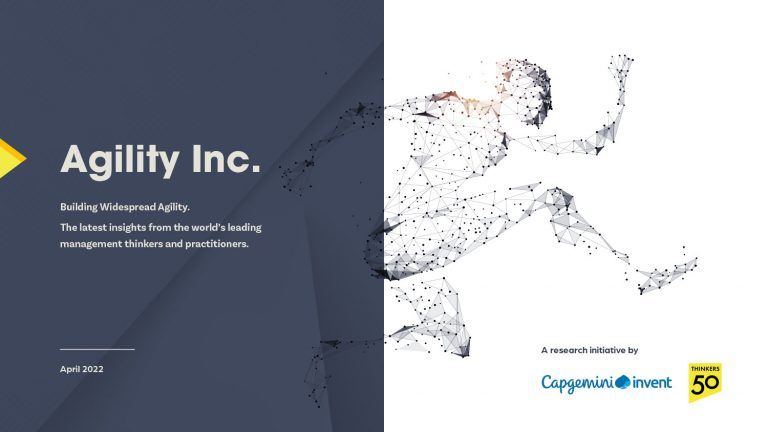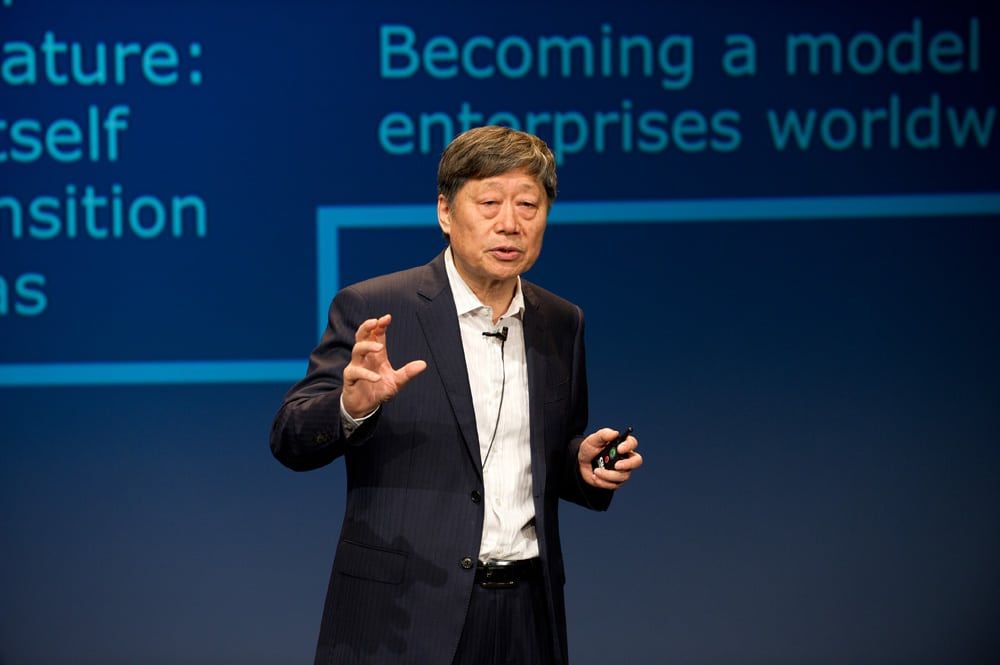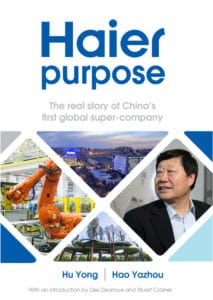

In the late 1990s, along with Huawei and Lenovo, after 20 years of development, the Chinese company Haier had developed into a large international company, but had never achieved a business structure, organizational structure, personnel structure or corresponding processes to match the scope of international companies. Haier Group was at a critical point in its development.
Haier’s reconstruction, which started in 1998, and lasted nearly 10 years, did not solve the above problem as the goal of that process had been to establish a set of operating systems for procurement, sales and so on, and to avoid conflicts after diversification. But, what was formed had its own problems – such as not really being connected to the market, resource waste and information distortion.
At that time, Haier was fragmented, and its 600 small computer systems could not be effectively integrated, so a series of ‘information islands’ were formed. When the business model changed, these small systems could only be abandoned. Haier CEO Zhang Ruimin was painfully aware that Haier had undergone several years of reconstruction without going far enough: ‘Walking around you could see that it did have some effect, but it did not bring about the desired integration of information within the enterprise.’ Therefore, starting from 26 April, 2007, Haier launched a period of information technology reconstruction lasting 1,000 days, with the intention of building 2000–2500 processes.
This 1,000 Day Revolution included organizational, process and personnel reconstruction. In terms of the organization, Haier wanted to build an operationally excellent business. The idea was to take Haier’s original information systems, which were distributed among different processes, and link them into an organic whole, so that all links in the chain were measured to the same, single goal which was that they could respond quickly to market requirements. In terms of personnel, the goal was to provide a way to enhance quality in an open environment, allowing collaboration and communication on information platforms, so that Haier staff could bring their energy and capability to the fore. The system was designed to have speed and accuracy, so that top talents could ensure operational excellence.
Zhang Ruimin says: ‘This reconstruction was not the same as the previous attempts. The idea was to embed information technology into the entire system.’ Haier invested hundreds of millions to change the enterprise, to allow a reconstruction based around information technology.
In three years it built up a comprehensive and innovative information processing and organizational system. This allowed information to flow throughout the entire process, so that the system could respond immediately to events. Any customer demand or sign of trouble would be instantly fed back through every aspect of the process. If a new market order was raised, the order requirements would be instantly reflected throughout all sectors from marketing, research and development, supply, manufacturing, financial, human resources, etc., allowing simultaneous action throughout the entire chain, while also integrating resources. The system would automatically create a project to complete the order. This meant that orders could be met in the shortest possible time. In this process, everything became automatic. Because there were pre-budget processes, a ‘zero signature’ system could be achieved; because of the internal closed-loop process, it was possible to have a ‘zero approval’ system; and since the process was close to the market, it was also possible to achieve ‘zero delays’. The entire process system may seem complicated to outsiders, but for customers, it was the easiest system to deal with.
This complex system is not a ‘split execution’ process, but an ‘instant process’ implemented jointly throughout the company. This means that customer demand and order objectives are clear, so the goods do not stay in storage and finances flow in the fastest way possible. It is an end-to-end system. Zhang Ruimin had stipulated that: ‘Reconstruction must be objective and results-oriented; the criterion for the reconstruction is to build a process that works from target to target, from user to user, from end to end.’
 In August 2007, Haier computers won an exclusive international tender for a Macedonian government computer project. When the prototype needed urgent revision, Haier’s innovative internationalization process platform played a key role. Haier’s Intel Product Innovation Centre, as well as the R&D centres in Germany, South Korea and Chinese Taiwan all started work at the same time. The design was quickly sent to the world’s most outstanding manufacturing enterprises and prototype design changes were completed in the shortest possible time. This immediate response process enabled Haier to take home orders of up to $30 million.
In August 2007, Haier computers won an exclusive international tender for a Macedonian government computer project. When the prototype needed urgent revision, Haier’s innovative internationalization process platform played a key role. Haier’s Intel Product Innovation Centre, as well as the R&D centres in Germany, South Korea and Chinese Taiwan all started work at the same time. The design was quickly sent to the world’s most outstanding manufacturing enterprises and prototype design changes were completed in the shortest possible time. This immediate response process enabled Haier to take home orders of up to $30 million.
This is an edited extract from Haier Purpose by Hu Yong and Hao Yazhou now available from Thinkers50 and Infinite ideas.

Thinkers50 Limited
The Studio
Highfield Lane
Wargrave RG10 8PZ
United Kingdom

Thinkers50 Limited
The Studio
Highfield Lane
Wargrave RG10 8PZ
United Kingdom

| Cookie | Duration | Description |
|---|---|---|
| LANG | 9 hours | Linkedin set this cookie to set user's preferred language. |
| nsid | session | This cookie is set by the provider PayPal to enable the PayPal payment service in the website. |
| sp_landing | 1 day | The sp_landing is set by Spotify to implement audio content from Spotify on the website and also registers information on user interaction related to the audio content. |
| sp_t | 1 year | The sp_t cookie is set by Spotify to implement audio content from Spotify on the website and also registers information on user interaction related to the audio content. |
| tsrce | 3 days | PayPal sets this cookie to enable the PayPal payment service in the website. |
| x-pp-s | session | PayPal sets this cookie to process payments on the site. |
| __cf_bm | 30 minutes | This cookie, set by Cloudflare, is used to support Cloudflare Bot Management. |
| Cookie | Duration | Description |
|---|---|---|
| l7_az | 30 minutes | This cookie is necessary for the PayPal login-function on the website. |
| Cookie | Duration | Description |
|---|---|---|
| CONSENT | 2 years | YouTube sets this cookie via embedded youtube-videos and registers anonymous statistical data. |
| _ga | 2 years | The _ga cookie, installed by Google Analytics, calculates visitor, session and campaign data and also keeps track of site usage for the site's analytics report. The cookie stores information anonymously and assigns a randomly generated number to recognize unique visitors. |
| _gat_gtag_UA_10408481_1 | 1 minute | Set by Google to distinguish users. |
| _ga_ZP8HQ8RZXS | 2 years | This cookie is installed by Google Analytics. |
| _gid | 1 day | Installed by Google Analytics, _gid cookie stores information on how visitors use a website, while also creating an analytics report of the website's performance. Some of the data that are collected include the number of visitors, their source, and the pages they visit anonymously. |
| Cookie | Duration | Description |
|---|---|---|
| NID | 6 months | NID cookie, set by Google, is used for advertising purposes; to limit the number of times the user sees an ad, to mute unwanted ads, and to measure the effectiveness of ads. |
| test_cookie | 15 minutes | The test_cookie is set by doubleclick.net and is used to determine if the user's browser supports cookies. |
| VISITOR_INFO1_LIVE | 5 months 27 days | A cookie set by YouTube to measure bandwidth that determines whether the user gets the new or old player interface. |
| YSC | session | YSC cookie is set by Youtube and is used to track the views of embedded videos on Youtube pages. |
| yt-remote-connected-devices | never | YouTube sets this cookie to store the video preferences of the user using embedded YouTube video. |
| yt-remote-device-id | never | YouTube sets this cookie to store the video preferences of the user using embedded YouTube video. |
| yt.innertube::nextId | never | This cookie, set by YouTube, registers a unique ID to store data on what videos from YouTube the user has seen. |
| yt.innertube::requests | never | This cookie, set by YouTube, registers a unique ID to store data on what videos from YouTube the user has seen. |
| Cookie | Duration | Description |
|---|---|---|
| DEVICE_INFO | 5 months 27 days | No description |
| loglevel | never | No description available. |
| m | 2 years | No description available. |
Thinkers50 Limited has updated its Privacy Policy on 28 March 2024 with several amendments and additions to the previous version, to fully incorporate to the text information required by current applicable date protection regulation. Processing of the personal data of Thinkers50’s customers, potential customers and other stakeholders has not been changed essentially, but the texts have been clarified and amended to give more detailed information of the processing activities.